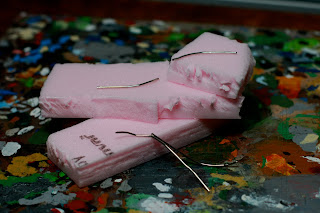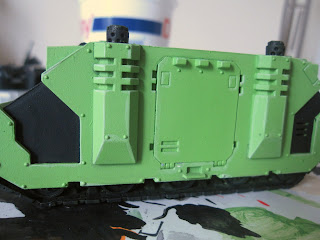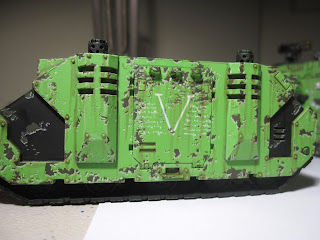Tank tracks are one of the easiest things you can weather on a vehicle. The method breaks down to painting the metal, giving them a heavy wash, drybrushing metallic and a final dusting.
I can't just give that little info though now can I? In this I'll run you through the basics of painting and at the same time weathering tank tracks to a great tabletop standard. Again, it's all from my latest Sons of Medusa Razorback! That APC has been a well of great tips!
I always start off with a black base color for my tracks. Paint the tracks, the road wheels, sides and inside of your tracks, you really want to be thorough with this step, it's the cover up that will keep things from looking off should you miss a few spots with the later steps, in this case, I would have a bright green showing through on my track if I wasn't sure to hit all facets of the track links. By the time your finished the first spot you painted should be about dry, unless you use really watered down paint that is. Watered down paint helps when painting tracks, but you need to wait longer and do a few coats to get even opacity.
Boltgun Metal is applied loosely and heavily. Slightly watered to give me a bit more speed of coverage in those hard to reach spots. For nearly all of the painting you can use a larger brush that will hold a larger volume of paint. It's as simple as 'Larger area, larger brush'.
To give that rusty look, I use a VERY heavy wash of Bestial Brown watered down to a milk consistency. I slop it on the tracks and allow it to pool all around and in the cracks. A second wash might be necessary if you watered your brown down too much. See the above for the final result you're looking for with the wash.
Once your wash is dry, which will take a while, break out your Boltgun Metal again and give your tracks a heavy drybrush to the raised surfaces. This is to show the wear to the track by the vehicles operation. The contact points will be worn away and bare metal showing through.
To finish the tracks off, I use a quick dusting of Bleached Bone. To 'dust' with paint you simply need to set your brush and paint as if you were going to drybrush, but continue to wipe paint off the brush until almost nothing is coming off. When painting, start with light pressure and work harder until you get a slight sheen of the color.
In the end you should have a nicely weathered looking tread with little effort. The longest part of this method is the drying time wait. I've used this method on a few different models in my Sons of Medusa army, each time it's enhanced the gritty hard fought look I've been going for.



















































